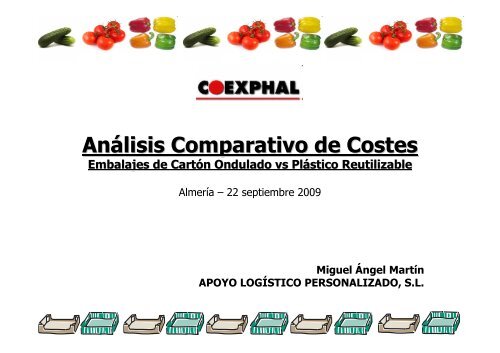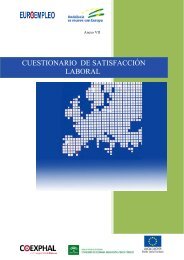Embalajes de Cartón Ondulado vs Plástico Reutilizable - Coexphal
Embalajes de Cartón Ondulado vs Plástico Reutilizable - Coexphal
Embalajes de Cartón Ondulado vs Plástico Reutilizable - Coexphal
Create successful ePaper yourself
Turn your PDF publications into a flip-book with our unique Google optimized e-Paper software.
Análisis Comparativo Comparativo<br />
<strong>de</strong> Costes<br />
<strong>Embalajes</strong> <strong>de</strong> <strong>Cartón</strong> <strong>Ondulado</strong> <strong>vs</strong> <strong>Plástico</strong> <strong>Reutilizable</strong><br />
Almería – 22 septiembre 2009<br />
Miguel Ángel Martín<br />
APOYO LOGÍSTICO PERSONALIZADO, S.L.
ÍNDICE<br />
1. Evolución <strong>de</strong> los embalajes <strong>de</strong> uso agrícola<br />
2. ¿Cómo elegir el mejor embalaje?<br />
3. Diseño <strong>de</strong>l estudio<br />
4. Resultados y conclusiones
1. EVOLUCIÓN DE LOS EMBALAJES DE USO AGRÍCOLA<br />
MADERA<br />
CARTÓN<br />
ONDULADO<br />
PLÁSTICO<br />
REUTILIZABLE
¿CÓMO ELEGIR EL MEJOR EMBALAJE?<br />
TEORÍA<br />
- Protección<br />
- Efectos sobre marca<br />
- Higiene y seguridad alimentaria<br />
- Sostenibilidad medioambiental<br />
- Costes iniciales<br />
- Costes operativos / logísticos<br />
- Costes financieros<br />
CADENA SUMINISTRO: VARIOS AGENTES<br />
VARIOS FACTORES<br />
PRÁCTICA<br />
COMISIÓN €<br />
POOLS PLÁSTICO → DISTRIBUIDOR<br />
DISTRIBUIDOR: ÚNICO PROTAGONISTA<br />
UN ÚNICO FACTOR DETERMINANTE
DISEÑO DEL ESTUDIO<br />
1. OBJETIVO: Conocer la diferencia <strong>de</strong> costes asociados al uso <strong>de</strong><br />
embalajes <strong>de</strong> cartón ondulado respecto a los embalajes<br />
<strong>de</strong> plástico reutilizable.<br />
2. ALCANCE: Tomates + Pepinos + Pimientos producidos en Almería.<br />
3. METODOLOGÍA:<br />
a) Recopilación <strong>de</strong> datos<br />
b) Análisis y tratamiento matemático <strong>de</strong> los datos<br />
c) Obtención <strong>de</strong> resultados<br />
d) Comparación <strong>de</strong> resultados<br />
e) Extrapolación<br />
4. CONCLUSIONES
DISEÑO DEL ESTUDIO<br />
CARTÓN<br />
IFCO<br />
EPS<br />
CAJA 5 Kg<br />
30x40x14<br />
30x40x16,7<br />
(4314)<br />
40x30x15,3<br />
(154)<br />
TOMATE<br />
CAJA 6 Kg<br />
60x40x9<br />
60x40x12,5<br />
(6410)<br />
60x40x12,3<br />
(136)<br />
PIMIENTO<br />
CAJA 5 Kg<br />
60x40x10<br />
60x40x12,5<br />
(6410)<br />
60x40x12,3<br />
(136)<br />
CAJA 6 Kg<br />
40x30x14<br />
40x30x16,7<br />
(4314)<br />
40x30x15,3<br />
(154)<br />
PEPINO<br />
CAJA 8 Kg<br />
60x40x10<br />
60x40x12,5<br />
(6410)<br />
60x40x12,3<br />
(136)
RECOPILACIÓN Y TRATAMIENTO DE DATOS<br />
DATOS REALES DE ORIGEN (Empresas asociadas a COEXPHAL)<br />
- Medidas <strong>de</strong> las cajas utilizadas<br />
- Precio compra/alquiler cajas (+<strong>de</strong>pósito)<br />
- Plazos <strong>de</strong> pago<br />
- Altura palets<br />
- Precio bruto <strong>de</strong>l producto comercializado<br />
- Precio etiquetas + plásticos <strong>de</strong> protección<br />
- Precio alquiler paletas<br />
- Coste mano <strong>de</strong> obra<br />
- Cantidad <strong>de</strong> producto envasado por hora y trabajador<br />
- Precio <strong>de</strong>l transporte por camión (diversos <strong>de</strong>stinos)<br />
- Porcentaje <strong>de</strong> pérdidas y roturas<br />
- Espacio ocupado por embalajes vacíos en almacén<br />
- Etc.
RECOPILACIÓN Y TRATAMIENTO DE DATOS<br />
DATOS ELABORADOS<br />
- Logísticos:<br />
. Cantidad <strong>de</strong> cajas, paletas, etc.<br />
- Transporte:<br />
. Camiones necesarios para cajas vacías, paletas vacías, entregar F&H, etc.<br />
- Envasador:<br />
. Coste <strong>de</strong> mano obra, compra/alquiler cajas y paletas, transporte,<br />
coste financiero, administrativo, almacenamiento, etiquetas, etc.
RESULTADOS<br />
1<br />
TOMATE<br />
PEPINO<br />
PIMIENTO<br />
El envasador pue<strong>de</strong> llegar a ahorrar<br />
el equivalente a un 6% - 13% <strong>de</strong> su facturación<br />
utilizando <strong>Cartón</strong> <strong>Ondulado</strong> en lugar <strong>de</strong> <strong>Plástico</strong> <strong>Reutilizable</strong><br />
30x40<br />
7,14<br />
13,3<br />
-<br />
Total<br />
7,76<br />
12,46<br />
60x40<br />
8,37<br />
11,72<br />
8,07<br />
Exportación<br />
30x40<br />
7,43<br />
8,25<br />
60x40<br />
9,07<br />
30x40<br />
6,25<br />
Nacional<br />
6,27<br />
60x40<br />
6,30
RESULTADOS<br />
2<br />
El envasador pue<strong>de</strong> llegar a ahorrar<br />
entre 7 y 12 céntimos <strong>de</strong> € por Kg <strong>de</strong> producto<br />
utilizando <strong>Cartón</strong> <strong>Ondulado</strong> en lugar <strong>de</strong> <strong>Plástico</strong> <strong>Reutilizable</strong><br />
TOMATE<br />
PEPINO<br />
PIMIENTO<br />
30x40<br />
6,77<br />
10,09<br />
-<br />
Total<br />
6,98<br />
8,65<br />
60x40<br />
7,95<br />
7,57<br />
12,13<br />
Exportación<br />
30x40<br />
7,05<br />
7,90<br />
60x40<br />
8,61<br />
30x40<br />
5,93<br />
Nacional<br />
5,95<br />
60x40<br />
5,96
RESULTADOS<br />
3<br />
El envasador pue<strong>de</strong> llegar a ahorrar<br />
entre 30 y 60 céntimos <strong>de</strong> € por caja comercializada<br />
utilizando <strong>Cartón</strong> <strong>Ondulado</strong> en lugar <strong>de</strong> <strong>Plástico</strong> <strong>Reutilizable</strong><br />
TOMATE<br />
PEPINO<br />
PIMIENTO<br />
30x40<br />
34<br />
55<br />
-<br />
Total<br />
38<br />
61<br />
60x40<br />
48<br />
66<br />
61<br />
Exportación<br />
30x40<br />
35<br />
43<br />
60x40<br />
52<br />
30x40<br />
30<br />
Nacional<br />
33<br />
60x40<br />
36
RESULTADOS<br />
4<br />
TOMATE<br />
PEPINO<br />
PIMIENTO<br />
Para el envasador,<br />
el plástico es un 20% - 30% más caro que el cartón<br />
30x40<br />
17,8<br />
31,9<br />
-<br />
Total<br />
20,4<br />
32,5<br />
60x40<br />
22,5<br />
33,0<br />
29,4<br />
Exportación<br />
30x40<br />
16,9<br />
20,0<br />
60x40<br />
22,4<br />
30x40<br />
21,7<br />
Nacional<br />
20,2<br />
60x40<br />
22,6
RESULTADOS: EXTRAPOLACIÓN PARA TODA ALMERÍA<br />
5<br />
Almería podría ahorrarse casi 90 millones €<br />
utilizando sólo embalajes <strong>de</strong> cartón ondulado<br />
para comercializar tomates, pepinos y pimientos<br />
(frente a la hipótesis <strong>de</strong> utilizar sólo embalajes plegables <strong>de</strong> plástico)<br />
TOMATE<br />
PEPINO<br />
PIMIENTO<br />
Toneladas (*)<br />
577.236<br />
192.164<br />
239.385<br />
Facturación<br />
aproximada<br />
550 millones €<br />
135 millones €<br />
360 millones €<br />
Posible<br />
ahorro<br />
42 millones €<br />
17 millones €<br />
29 millones €<br />
AHORRO TOTAL<br />
(para estos 3<br />
productos)<br />
88 MILLONES €<br />
(*) Fuente: COEXPHAL – Dpto. <strong>de</strong> Estadística. Campaña 2008-2009
¿POR QUÉ TANTA DIFERENCIA?<br />
- El plástico tiene un mayor coste inicial (alquiler cajas)<br />
- Las cajas <strong>de</strong> plástico suelen ser más altas (peor adaptación al contenido).<br />
Transportar aire también se paga:<br />
· más palets<br />
· más camiones<br />
· más mano <strong>de</strong> obra <strong>de</strong> carga / <strong>de</strong>scarga <strong>de</strong> camiones<br />
- Las cajas rotas o perdidas <strong>de</strong> plástico tienen un coste extra (<strong>de</strong>pósito)<br />
- Etiquetado <strong>de</strong> cajas <strong>de</strong> plástico más caro (material y/o mano <strong>de</strong> obra)<br />
- El montaje y el movimiento <strong>de</strong> las cajas <strong>de</strong> cartón en las instalaciones <strong>de</strong>l<br />
envasador está automatizado (máquinas + aéreos), mientras que para las<br />
cajas <strong>de</strong> plástico es manual: mayor coste mano <strong>de</strong> obra<br />
- En algunos casos es necesario un plástico <strong>de</strong> protección extra en las cajas<br />
<strong>de</strong> plástico.<br />
- El almacenamiento <strong>de</strong> las cajas <strong>de</strong> plástico es más caro.<br />
- El plástico tiene unos costes administrativos mayores.
RESUMEN<br />
1<br />
2<br />
3<br />
4<br />
5<br />
El envasador pue<strong>de</strong> llegar a ahorrar el equivalente a un<br />
6% - 13% <strong>de</strong> su facturación utilizando <strong>Cartón</strong> <strong>Ondulado</strong> en lugar <strong>de</strong><br />
<strong>Plástico</strong> <strong>Reutilizable</strong><br />
El envasador pue<strong>de</strong> llegar a ahorrar entre 7 y 12 c€/Kg <strong>de</strong> producto<br />
utilizando <strong>Cartón</strong> <strong>Ondulado</strong> en lugar <strong>de</strong> <strong>Plástico</strong> <strong>Reutilizable</strong><br />
El envasador pue<strong>de</strong> llegar a ahorrar entre 30 y 60 c€/caja<br />
comercializada utilizando <strong>Cartón</strong> <strong>Ondulado</strong> en lugar <strong>de</strong> <strong>Plástico</strong><br />
<strong>Reutilizable</strong><br />
Para el envasador, el plástico es un 20% - 30% más caro que el<br />
cartón<br />
Almería podría ahorrarse casi 90 millones € utilizando sólo<br />
embalajes <strong>de</strong> cartón ondulado para comercializar tomates,<br />
pepinos y pimientos<br />
(frente a la hipótesis <strong>de</strong> utilizar sólo embalajes plegables <strong>de</strong> plástico)
Análisis Comparativo Comparativo<br />
<strong>de</strong> Costes<br />
<strong>Embalajes</strong> <strong>de</strong> <strong>Cartón</strong> <strong>Ondulado</strong> <strong>vs</strong> <strong>Plástico</strong> <strong>Reutilizable</strong><br />
Almería – 22 septiembre 2009<br />
Miguel Ángel Martín<br />
APOYO LOGÍSTICO PERSONALIZADO, S.L.



